The Effect of Various Grinding Aids on the Properties of Cement and Its Compatibility with Acrylate-Based Superplasticizer
Abstract
:1. Introduction
2. Materials and Methods
3. Results
3.1. Grindability and Grain Size Distribution of Cements
3.2. Standard Properties of Cements
3.3. Rheological Properties of Cement Pastes: Viscosity η and Yield Stress τ0
- —shear stress, Pa;
- —yield stress, Pa;
- —shear rate, s−1;
- —plastic viscosity, Pa∙s.
4. Conclusions
Author Contributions
Funding
Institutional Review Board Statement
Informed Consent Statement
Data Availability Statement
Conflicts of Interest
References
- Bensted, J.; Smith, J.R. Grinding aids during cement manufacture. Cem. Wapno Beton 2009, 4, 179–188. [Google Scholar]
- Kurdowski, W. Cement and Concrete Chemistry; Springer Science & Business: Berlin/Heidelberg, Germany, 2014. [Google Scholar]
- Pérez-Velázquez, A.; Pérez-Calvo, J.F. Low Cost Grinding Aids for Cement. World’scement.com. 2009. Available online: https://www.proquicesa.com/wp-content/uploads/2018/07/World_Cement_-_ADITOR_M_-_Low_Cost_Grinding_Aids_for_Cement_-_Web.pdf (accessed on 5 December 2021).
- Mishra, R.K.; Heinz, H.; Zimmermann, J.; Müller, T.; Flatt, R.J. Understanding the effectiveness of polycarboxylates as grinding aids. Spec. Publ. 2012, 288, 1–15. [Google Scholar]
- Weibel, M.; Mishra, R.K. Comprehensive understanding of grinding aids. Zem.-Kalk-Gips 2014, 6, 28–39. [Google Scholar]
- Kubik, J.; Perkowski, Z. Weakening of strength of capillary-porous materials as result of moistening. Zesz. Nauk. Politech. Śląskiej 2005, 31, 101–108. [Google Scholar]
- Assaad, J.J.; Issa, C.A. Effect of clinker grinding aids on flow of cement-based materials. Cem. Concr. Res. 2014, 63, 1–11. [Google Scholar] [CrossRef]
- Gustaw, K.; Roszczynialski, W. Mielenie cementu w młynach mini pebs z dodatkiem flotanolu jako środka powierzchniowo czynnego. Cem. Wapno Gips 1980, 47, 8–9. [Google Scholar]
- Grzymek, J.; Gustaw, K.; Roszczynialski, W. Intensyfikacja procesu mielenia cementu przy zastosowaniu odpadowych substancji powierzchniowo czynnych. Cem. Wapno Gips 1972, 39, 64. [Google Scholar]
- Heren, Z.; Ölmez, H. The influence of ethanolamines on the hydration and mechanical properties of portland cement. Cem. Concr. Res. 1996, 26, 701–705. [Google Scholar] [CrossRef]
- Katsioti, M.; Tsakiridis, P.E.; Giannatos, P.; Tsibouki, Z.; Marinos, J. Characterization of various cement grinding aids and their impact on grindability and cement performance. Constr. Build. Mater. 2009, 23, 1954–1959. [Google Scholar] [CrossRef]
- Aiad, I.; Mohammed, A.A.; Abo-El-Enein, S.A. Rheological properties of cement pastes admixed with some alkanolamines. Cem. Concr. Res. 2003, 33, 9–13. [Google Scholar] [CrossRef]
- Ramachandran, V.S. Hydration of cement—Role of triethanolamine. Cem. Concr. Res. 1976, 6, 623–632. [Google Scholar] [CrossRef] [Green Version]
- Lu, X.; Ye, Z.; Zhang, L.; Hou, P.; Cheng, X. The influence of ethanol-diisopropanolamine on the hydration and mechanical properties of Portland cement. Cem. Concr. Res. 2017, 135, 484–489. [Google Scholar] [CrossRef]
- Heren, Z.; Ölmez, H. The influence of ethanolamine on the surface properties of Portland cement pastes. Cem. Concr. Res. 1997, 27, 805–809. [Google Scholar] [CrossRef]
- Lieber, W.; Richartz, W. Effect of triethanolamine, sugar and boric acids on the setting and hardening of cements. Zem.-Kalk-Gips 1972, 25, 403–409. [Google Scholar]
- Ramachandran, V.S. Action of triethanolamine on the hydration of tricalcium aluminate. Cem. Concr. Res. 1973, 3, 41–54. [Google Scholar] [CrossRef] [Green Version]
- Lee, T.; Lee, J.; Choi, H.; Lee, D.-E. The Effects of fineness and TEA-based chemical admixture on early strength development of concrete in construction site application. Materials 2020, 13, 2027. [Google Scholar] [CrossRef] [PubMed]
- Zhang, Y.; Kong, X.; Lu, Z.; Lu, Z.; Zhang, Q.; Dong, B.; Xing, F. Influence of triethanolamine on the hydration product of portlandite in cement paste and the mechanism. Cem. Concr. Res. 2016, 87, 64–76. [Google Scholar]
- Han, J.; Wang, K.; Shi, J.; Wang, Y. Mechanism of triethanolamine on Portland cement hydration process and microstructure characteristics. Constr. Build. Mater. 2015, 93, 457–462. [Google Scholar] [CrossRef]
- Szudek, W.; Gołek, Ł.; Malata, G.; Pytel, Z. Influence of waste glass powder addition on the microstructure and mechanical properties of autoclaved building materials. Materials 2022, 15, 434. [Google Scholar] [CrossRef]
- Kujawa, W.; Olewnik-Kruszkowska, E.; Nowaczyk, J. Concrete Strengthening by Introducing Polymer-Based Additives into the Cement Matrix—A Mini Review. Materials 2021, 14, 6071. [Google Scholar] [CrossRef]
- Yamada, K. Basics of analytical methods used for the investigation of interaction mechanism between cements and superplasticizers. Cem. Concr. Res. 2011, 41, 793–798. [Google Scholar] [CrossRef]
- Hanehara, S.; Yamada, K. Rheology and early age properties of cement systems. Cem. Concr. Res. 2008, 38, 175–195. [Google Scholar] [CrossRef]
- Zhang, Y.; Luo, X.; Kong, X.; Wang, F.; Gao, L. Rheological properties and microstructure of fresh cement pastes with varied dispersion media and superplasticizers. Powder Technol. 2018, 330, 219–227. [Google Scholar] [CrossRef]
- Jiao, D.; Shi, C.; Yuan, Q.; An, X.; Liu, Y.; Li, H. Effect of constituents on rheological properties of fresh concrete—A review. Cem. Concr. Compos. 2017, 83, 146–159. [Google Scholar] [CrossRef]
- Gołaszewski, J. Influence of cement properties on new generation superplasticizers performance. Constr. Build. Mater. 2012, 35, 586–596. [Google Scholar] [CrossRef]
- Kaszyńska, M.; Skibicki, S.; Hoffmann, M. 3D Concrete Printing for Sustainable Construction. Energies 2020, 13, 6351. [Google Scholar] [CrossRef]
- Hoffmann, M.; Skibicki, S.; Pankratow, P.; Zieliński, A.; Pajor, M.; Techman, M. Automation in the Construction of a 3D-Printed Concrete Wall with the Use of a Lintel Gripper. Materials 2020, 13, 1800. [Google Scholar] [CrossRef] [Green Version]
- Kaszyńska, M.; Zieliński, A. Influence of mixture composition on shrinkage cracking of lightweight self-consolidating concrete. Brittle Matrix Comp. 2012, 10, 265–274. [Google Scholar]
- Felekoglu, B.; Tosun, K.; Baradan, B. Compatibility of a polycarboxylate-based superplasticiser with different set-controlling admixtures. Constr. Build. Mater. 2011, 25, 1466–1473. [Google Scholar] [CrossRef]
- PN-EN 1015-3:2000+A2:2007; Test Methods of Mortars for Walls. Determining the Consistency of Fresh Mortar (Using a Flow Table). Comite Europeen de Normalisation: Warsaw, Poland, 2007.
- PN-EN 196-3: 2018; Cement Testing Methods. Part 3: Determination of Setting Times and Volume Stability. Polish Committee for Standardization: Warsaw, Poland, 2018.
- PN-EN 196-1: 2016; Cement Testing Methods. Part 3: Determination of Strength. Polish Committee for Standardization: Warsaw, Poland, 2016.
- PN-EN ISO 10426-2:2003; Przemysł Naftowy i Gazowniczy–Cementy i Materiały do Cementowania Otworów Wiertniczych–Część 2: Badania Cementów Wiertniczych. The Polish Committee for Standardization: Warsaw, Poland, 2003.
- Mikanovic, N.; Jolicoeur, C. Influence of superplasticizers on the rheology and stability of limestone and cement pastes. Cem. Concr. Res. 2008, 38, 907–919. [Google Scholar] [CrossRef]
- Wiśniowski, R.; Skrzypaszek, K.; Małachowski, T. Selection of a Suitable Rheological Model for Drilling Fluid Using Applied Numerical Methods. Energies 2020, 13, 3192. [Google Scholar] [CrossRef]
- Sun, Z.; Liu, H.; Ji, Y.; Pang, M. Influence of glycerin grinding aid on the compatibility between cement and polycarboxylate superplasticizer and its mechanism. Constr. Build. Mater. 2020, 233, 117104. [Google Scholar] [CrossRef]



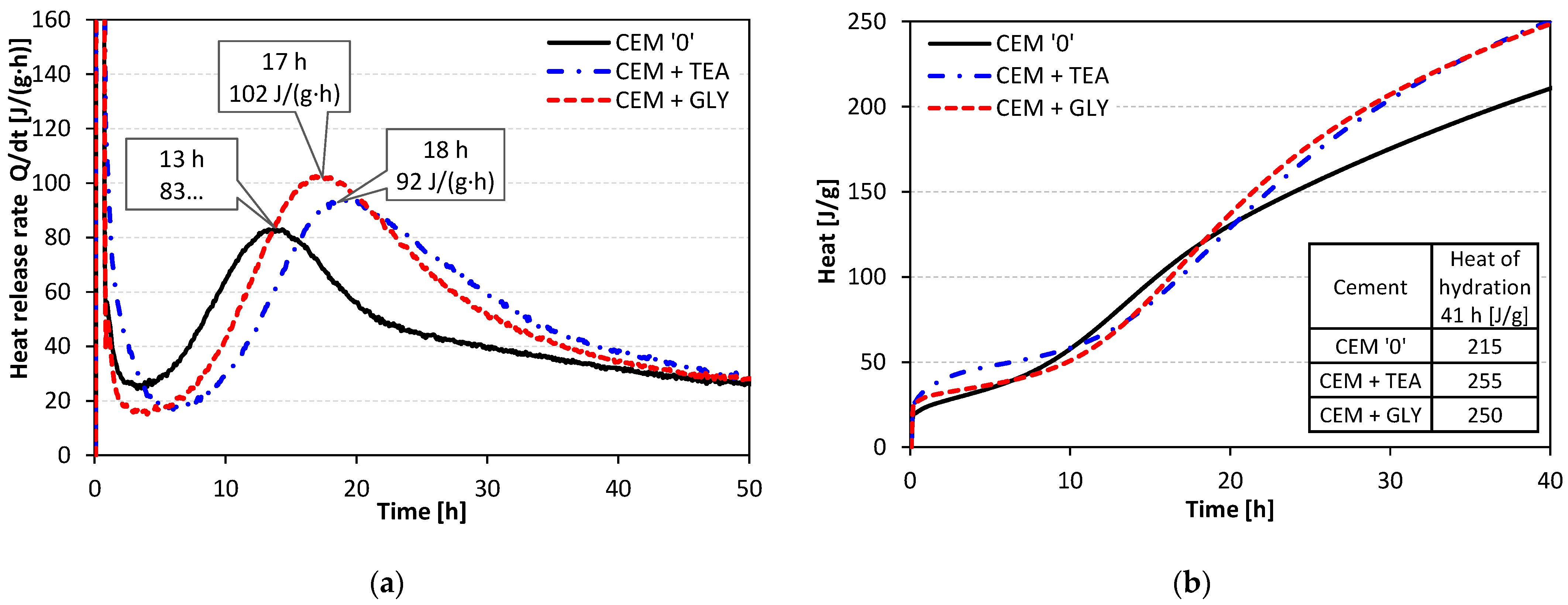
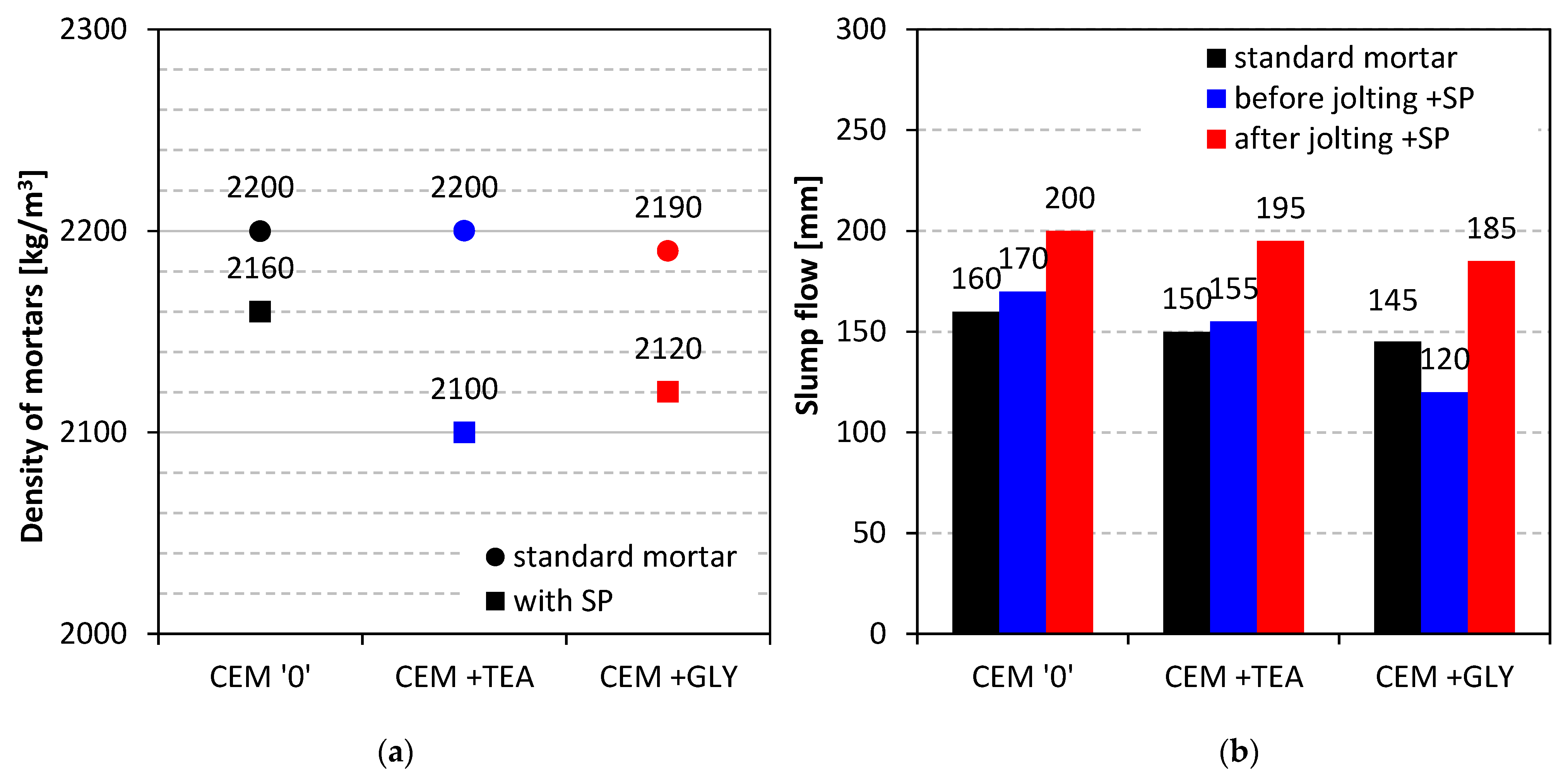

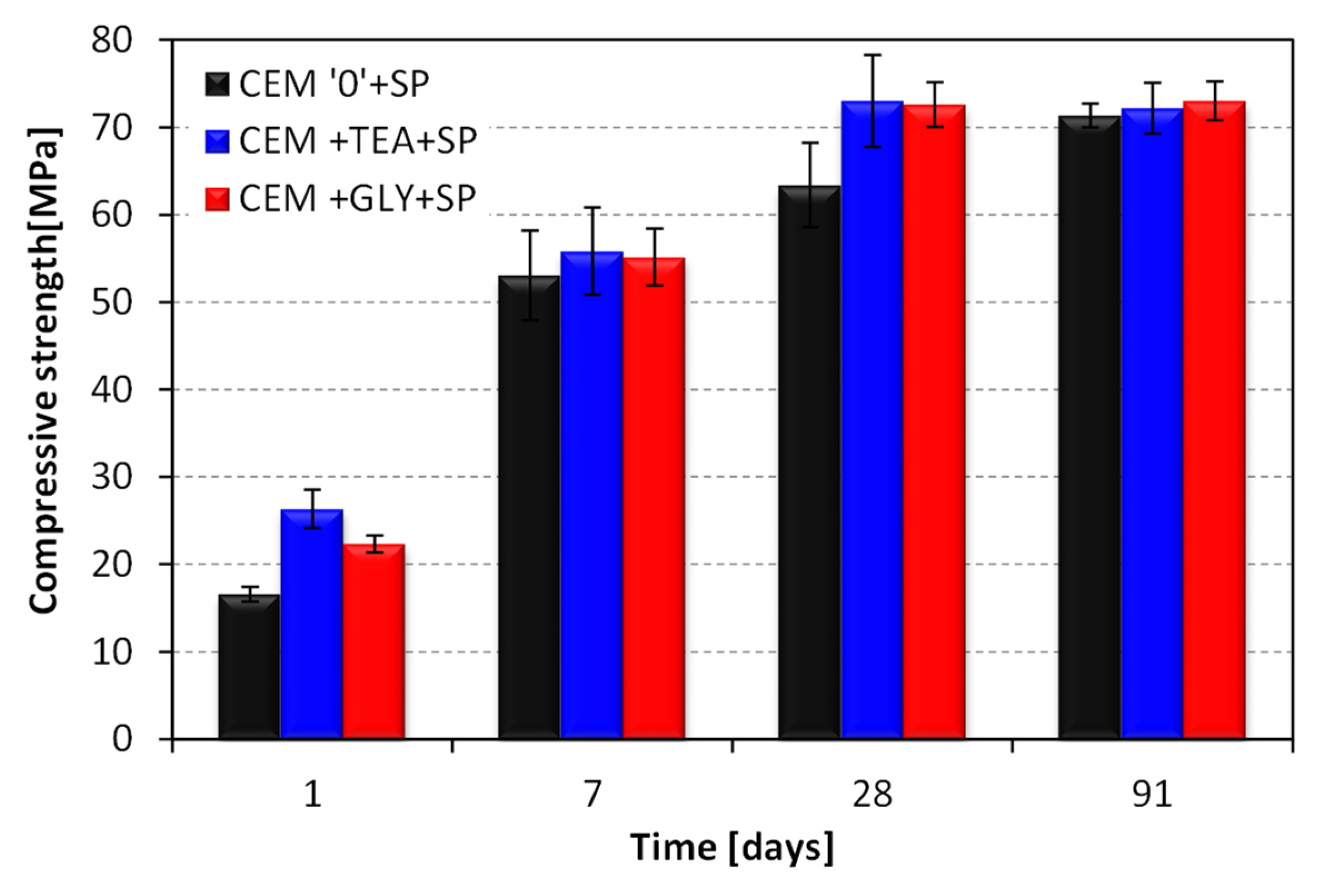

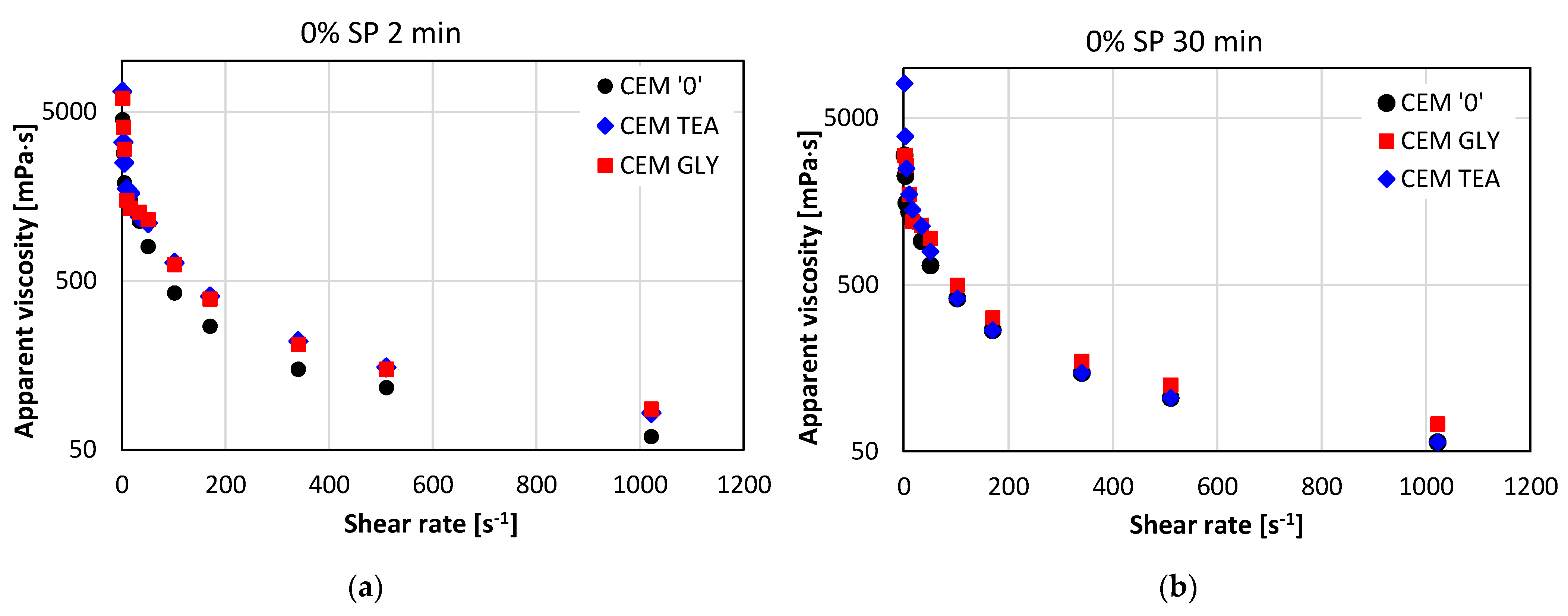

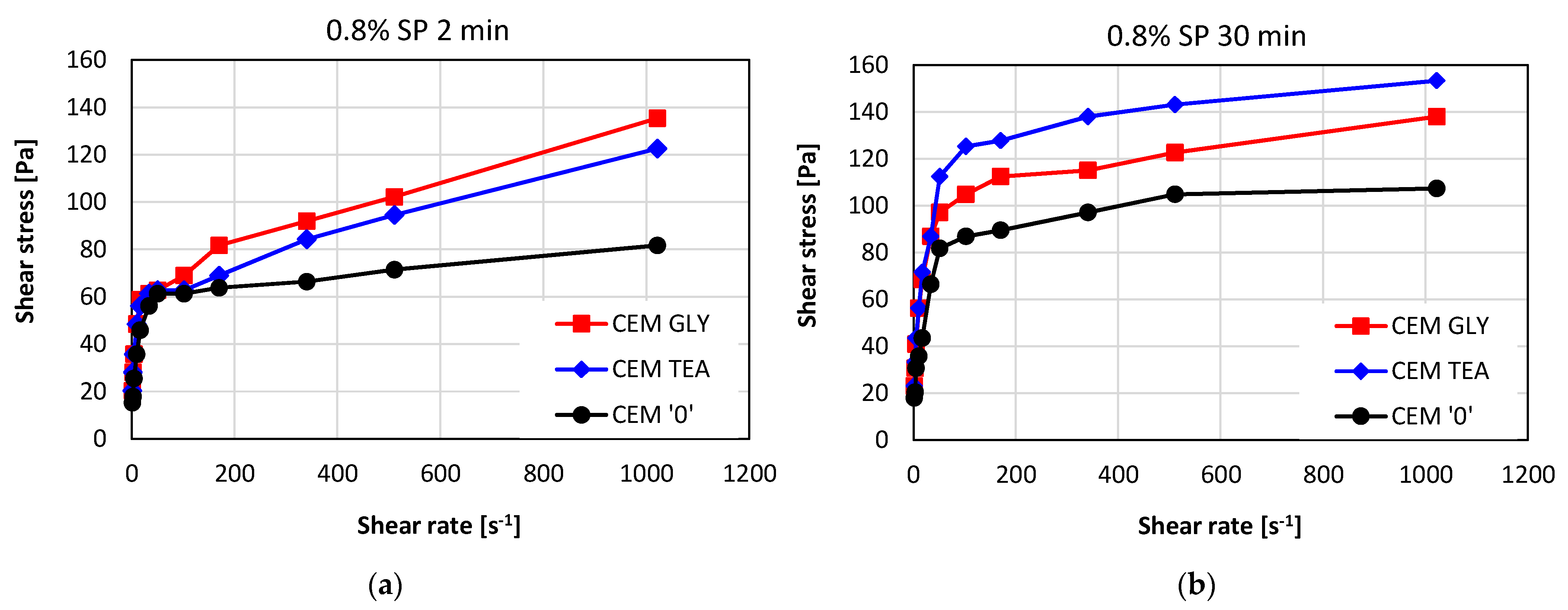
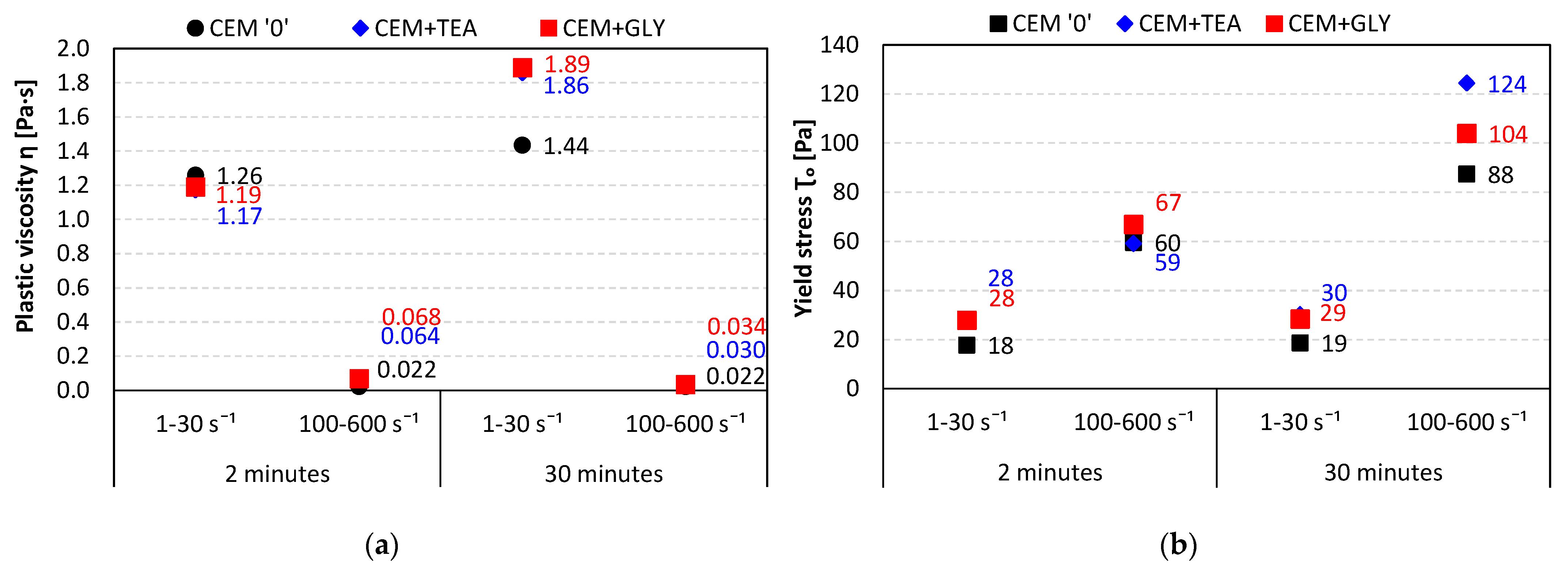
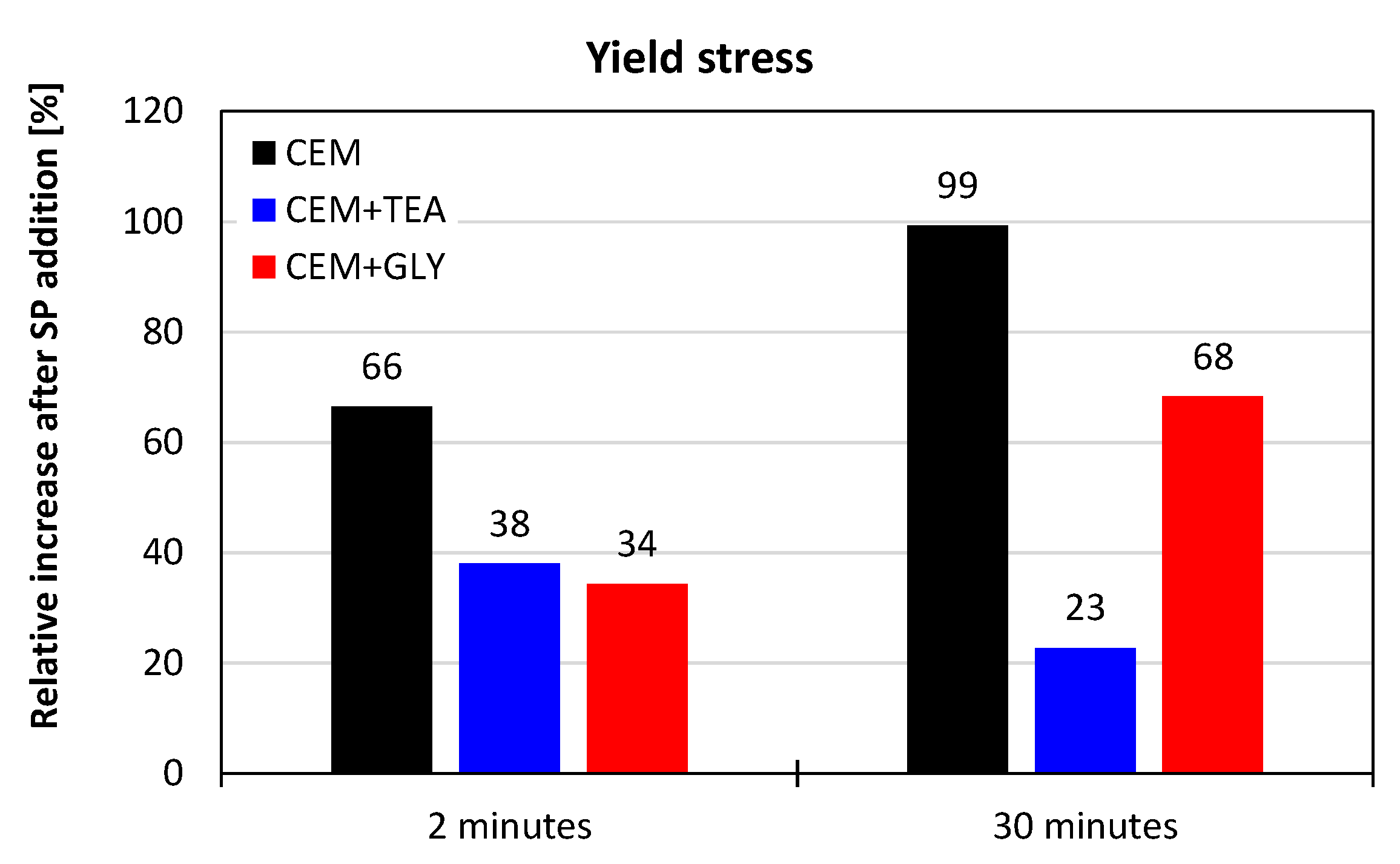
| Chemical Composition of Cement [%] | ||||||||
| LOI | CaO | SiO2 | Al2O3 | Fe2O3 | SO3 | K2O | Na2O | Cl |
| 2.08 | 65.6 | 22.4 | 4.3 | 2.5 | 3.1 | 0.5 | 0.3 | 0.1 |
| Phase Composition of Cement [%] | ||||||||
| C3S | C2S | C3A | C4AF | |||||
| 55.5 | 22.7 | 7.2 | 7.6 | 5.3 | ||||
| Cement | Clinker [%] | Anhydrite [%] | TEA [%] | GLY [%] |
|---|---|---|---|---|
| CEM ‘0’ | 95 | 5 | - | - |
| CEM + TEA | 95 | 5 | 0.1 * | - |
| CEM + GLY | 95 | 5 | - | 0.1 * |
| Mortar | Component | w/c | |||
|---|---|---|---|---|---|
| Cement [g] | Sand [g] | Water [g] | Superplasticizer [%] | ||
| CEM ‘0’ CEM + GLY CEM + TEA | 600 | 1350 | 300 | - | 0.5 |
| CEM ‘0’ + SP CEM + GLY + SP CEM + TEA + SP | 600 | 1350 | 240 | 0.6 | 0.4 |
| Paste | Component | w/c | ||
|---|---|---|---|---|
| Cement [g] | Water [g] | Superplasticizer [%] | ||
| CEM ‘0’ CEM + GLY CEM + TEA | 600 | 360 | - | 0.6 |
| CEM ‘0’ + SP CEM + GLY + SP CEM + TEA + SP | 600 | 240 | 0.8 | 0.4 |
| Sample | Water Demand [%] | Initial Setting Time [min] | Final Setting Time [min] |
|---|---|---|---|
| CEM ‘0’ | 26.4 | 140 | 200 |
| CEM + TEA | 28.8 | 160 | 220 |
| CEM + GLY | 28.4 | 170 | 220 |
Publisher’s Note: MDPI stays neutral with regard to jurisdictional claims in published maps and institutional affiliations. |
© 2022 by the authors. Licensee MDPI, Basel, Switzerland. This article is an open access article distributed under the terms and conditions of the Creative Commons Attribution (CC BY) license (https://creativecommons.org/licenses/by/4.0/).
Share and Cite
Kapeluszna, E.; Kotwica, Ł. The Effect of Various Grinding Aids on the Properties of Cement and Its Compatibility with Acrylate-Based Superplasticizer. Materials 2022, 15, 614. https://doi.org/10.3390/ma15020614
Kapeluszna E, Kotwica Ł. The Effect of Various Grinding Aids on the Properties of Cement and Its Compatibility with Acrylate-Based Superplasticizer. Materials. 2022; 15(2):614. https://doi.org/10.3390/ma15020614
Chicago/Turabian StyleKapeluszna, Ewa, and Łukasz Kotwica. 2022. "The Effect of Various Grinding Aids on the Properties of Cement and Its Compatibility with Acrylate-Based Superplasticizer" Materials 15, no. 2: 614. https://doi.org/10.3390/ma15020614






